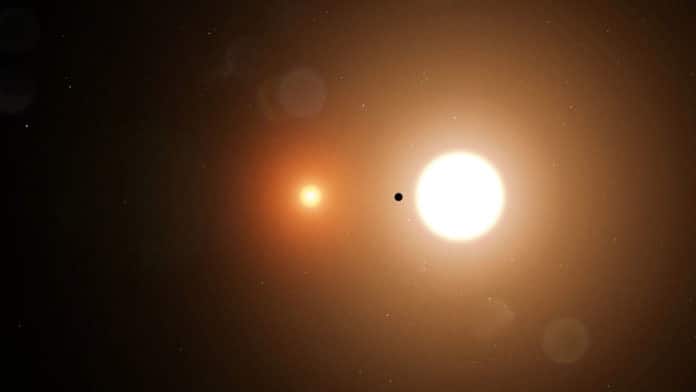While looking for the data the volunteers had flagged as an eclipsing binary, a system where two stars circle each other and from our view eclipse each other every orbit, Wolf Cukier at NASA’s Goddard Space Flight Center in Greenbelt, Maryland observed a signal coming from a system called TOI 1338. Initially, he assumed that the signal was a stellar eclipse, but later it turned out to be a planet.
TOI 1338 b, as it is now called, is TESS’s first circumbinary planet, a world orbiting two stars, lies 1,300 light-years away in the constellation Pictor. These two stars orbit each other every 15 days. Among the two, one is 10% more massive than our Sun, whereas the other is cooler, dimmer, and only one-third the Sun’s mass.
Planets orbiting two stars are quite challenging to detect. But, thanks to TESS, that made it possible to generate graphs of how the brightness of stars changes over time. Scientists observed that when a planet crosses in front of its star from our perspective, an event called a transit, its passage causes a distinct dip in the star’s brightness.
TOI 1338 b’s transits are irregular, between every 93 and 95 days, and vary in depth and duration on account of the orbital movement of its stars. TESS observes the transits crossing the more massive star; the transits of the smaller star are too faint to detect.
After identifying TOI 1338 b, the research team used a software package called Eleanor, named after Eleanor Arroway, the central character in Carl Sagan’s novel “Contact,” to confirm the transits were real and not a result of instrumental artifacts.
Co-author Adina Feinstein, a graduate student at the University of Chicago, said, “Throughout all of its images, TESS is monitoring millions of stars. That’s why our team created Eleanor. It’s an accessible way to download, analyze, and visualize transit data. We designed it with planets in mind, but other members of the community use it to study stars, asteroids, and even galaxies.”
The discovery was featured in a panel discussion on Monday, Jan. 6, at the 235th American Astronomical Society meeting in Honolulu. A paper, which Cukier co-authored along with scientists from Goddard, San Diego State University, the University of Chicago and other institutions, has been submitted to a scientific journal.
